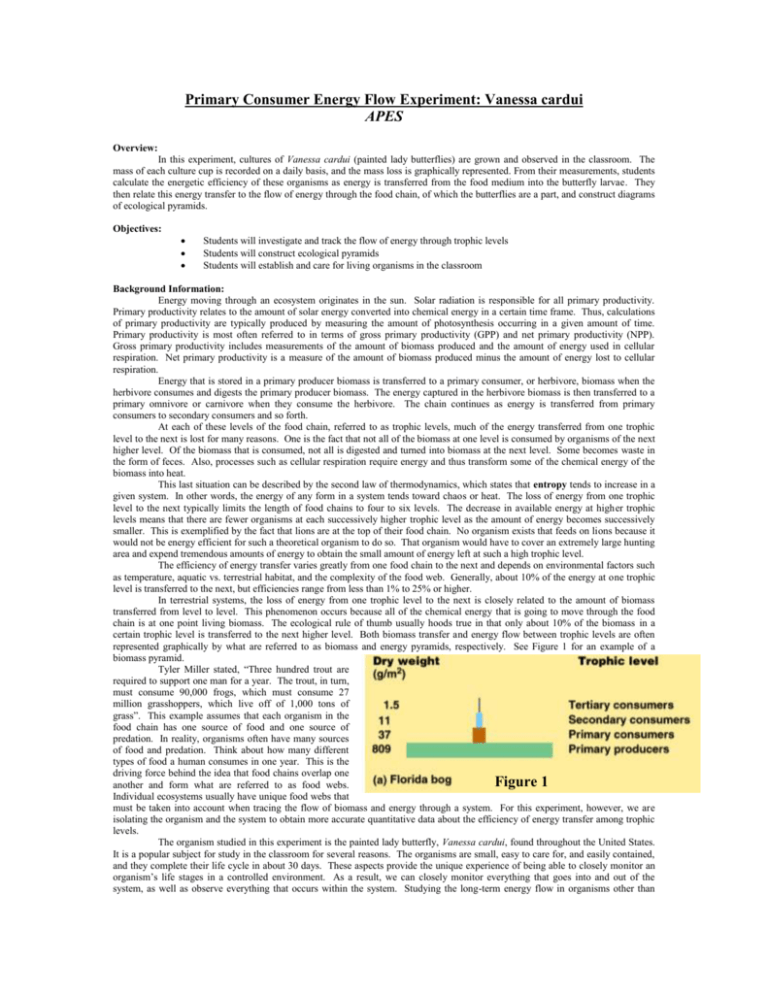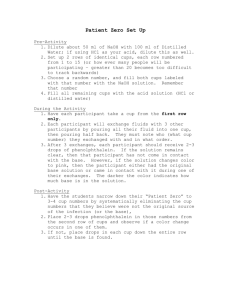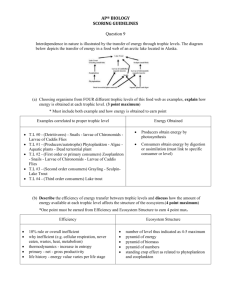Primary Consumer Energy Flow Experiment
advertisement

Primary Consumer Energy Flow Experiment: Vanessa cardui APES Overview: In this experiment, cultures of Vanessa cardui (painted lady butterflies) are grown and observed in the classroom. The mass of each culture cup is recorded on a daily basis, and the mass loss is graphically represented. From their measurements, students calculate the energetic efficiency of these organisms as energy is transferred from the food medium into the butterfly larvae. They then relate this energy transfer to the flow of energy through the food chain, of which the butterflies are a part, and construct diagrams of ecological pyramids. Objectives: Students will investigate and track the flow of energy through trophic levels Students will construct ecological pyramids Students will establish and care for living organisms in the classroom Background Information: Energy moving through an ecosystem originates in the sun. Solar radiation is responsible for all primary productivity. Primary productivity relates to the amount of solar energy converted into chemical energy in a certain time frame. Thus, calculations of primary productivity are typically produced by measuring the amount of photosynthesis occurring in a given amount of time. Primary productivity is most often referred to in terms of gross primary productivity (GPP) and net primary productivity (NPP). Gross primary productivity includes measurements of the amount of biomass produced and the amount of energy used in cellular respiration. Net primary productivity is a measure of the amount of biomass produced minus the amount of energy lost to cellular respiration. Energy that is stored in a primary producer biomass is transferred to a primary consumer, or herbivore, biomass when the herbivore consumes and digests the primary producer biomass. The energy captured in the herbivore biomass is then transferred to a primary omnivore or carnivore when they consume the herbivore. The chain continues as energy is transferred from primary consumers to secondary consumers and so forth. At each of these levels of the food chain, referred to as trophic levels, much of the energy transferred from one trophic level to the next is lost for many reasons. One is the fact that not all of the biomass at one level is consumed by organisms of the next higher level. Of the biomass that is consumed, not all is digested and turned into biomass at the next level. Some becomes waste in the form of feces. Also, processes such as cellular respiration require energy and thus transform some of the chemical energy of the biomass into heat. This last situation can be described by the second law of thermodynamics, which states that entropy tends to increase in a given system. In other words, the energy of any form in a system tends toward chaos or heat. The loss of energy from one trophic level to the next typically limits the length of food chains to four to six levels. The decrease in available energy at higher trophic levels means that there are fewer organisms at each successively higher trophic level as the amount of energy becomes successively smaller. This is exemplified by the fact that lions are at the top of their food chain. No organism exists that feeds on lions because it would not be energy efficient for such a theoretical organism to do so. That organism would have to cover an extremely large hunting area and expend tremendous amounts of energy to obtain the small amount of energy left at such a high trophic level. The efficiency of energy transfer varies greatly from one food chain to the next and depends on environmental factors such as temperature, aquatic vs. terrestrial habitat, and the complexity of the food web. Generally, about 10% of the energy at one trophic level is transferred to the next, but efficiencies range from less than 1% to 25% or higher. In terrestrial systems, the loss of energy from one trophic level to the next is closely related to the amount of biomass transferred from level to level. This phenomenon occurs because all of the chemical energy that is going to move through the food chain is at one point living biomass. The ecological rule of thumb usually hoods true in that only about 10% of the biomass in a certain trophic level is transferred to the next higher level. Both biomass transfer and energy flow between trophic levels are often represented graphically by what are referred to as biomass and energy pyramids, respectively. See Figure 1 for an example of a biomass pyramid. Tyler Miller stated, “Three hundred trout are required to support one man for a year. The trout, in turn, must consume 90,000 frogs, which must consume 27 million grasshoppers, which live off of 1,000 tons of grass”. This example assumes that each organism in the food chain has one source of food and one source of predation. In reality, organisms often have many sources of food and predation. Think about how many different types of food a human consumes in one year. This is the driving force behind the idea that food chains overlap one Figure 1 another and form what are referred to as food webs. Individual ecosystems usually have unique food webs that must be taken into account when tracing the flow of biomass and energy through a system. For this experiment, however, we are isolating the organism and the system to obtain more accurate quantitative data about the efficiency of energy transfer among trophic levels. The organism studied in this experiment is the painted lady butterfly, Vanessa cardui, found throughout the United States. It is a popular subject for study in the classroom for several reasons. The organisms are small, easy to care for, and easily contained, and they complete their life cycle in about 30 days. These aspects provide the unique experience of being able to closely monitor an organism’s life stages in a controlled environment. As a result, we can closely monitor everything that goes into and out of the system, as well as observe everything that occurs within the system. Studying the long-term energy flow in organisms other than plants is often difficult because of the many variables found in the organisms’ environments. With V. cardui, however, we can study energy flow at the trophic level of a consumer. The life cycle of the painted lady butterfly consists of four distinct stages. The first stage is the egg. Eggs are laid by adults on the surfaces of leaves of certain types of plants. Favorite plant species of the painted ladies are mallow and thistle. The tiny, mint-green-colored eggs hatch into small caterpillars in 5 to 10 days. During the second stage, or larval stage, the caterpillars feed on their host plant. The larvae experience a dramatic increase in body mass as they consume more and more food. The caterpillar’s exoskeleton does not stretch with the growth of the body, and thus the larva must shed its exoskeleton in order to continue its growth. This shedding is referred to as molting, and the stages between molts are called instars. The caterpillar usually has six instars. The last instar leads to the third stage of the painted lady’s life, the chrysalis. In this stage, the caterpillar crawls to an appropriate location such as the underside of a leaf, attaches itself with a pad of silk, and molts one last time resulting in a sac-like chrysalis that is usually found hanging upside down. The chrysalis protects the organism as it makes its metamorphosis from caterpillar to butterfly. The time spent in the chrysalis varies but is usually about one week. The end of the chrysalis stage is marked by the butterfly breaking open the chrysalis and crawling out into the fourth and final stage of its life as an adult. Butterflies feed on nectar using a proboscis located on the anterior portion of the organism. Adult painted ladies do not excrete solid frass (insect debris) as the caterpillars do. Rather, they often release a drop of liquid waste that is generally red in color. As an adult, the main purpose of the butterfly is to reproduce. After internal fertilization, females lay eggs, and both male and female organisms complete their life cycles in about 30 days. Procedure Get two culture cups with lids and one paper towel for your pair. With scissors, cut the paper towel in half. Set one half to the side to use later. From the other, cut two 5x5 cm squares Using a push pin, carefully punch four holes in each lid. The holes should be about 1 mm in diameter. Place one of the 5 cm squares of paper towel on the opening of each cup. Snap the lids into place on the cups, securing the paper towel across the opening of the cup. Using a permanent marker, label both the lid and the bottom of each cup. One should be designated as the control cup and the other as the larvae cup. Also, include your initials or other markings to distinguish your cups from those of the rest of the class. Create a data table in your quadrille similar to the one on the last page of this handout. Measure the masses of the empty control and larvae cup with an electronic balance. Record this value at least to 0.01 g in your data table. Take the lid and tissue paper off the control cup and place all three components on the balance. Reset the balance to zero. Using a wooden spatula, scoop and pack a 6 mm layer of food medium into the bottom of the cup, making sure the medium’s surface is smooth and even. With the remaining portion of paper towel, wipe any excess food from the lip and sides of the cup. Record this mass as the original mass of food medium in the appropriate space in your data table. Repeat the previous four steps for the larvae cup. Try to pack the same mass of food medium into the larvae cup that you packed into the control cup. Also, smooth the surface of both cups to make them as uniform as possible. Both of these processes will eliminate extra variables in the experiment. Record the mass of food medium in the larvae cup in your data table. With a sorting brush, gently brush three butterfly larvae into the cup labeled “larvae.” Replace the lids on both cups, securing the paper towel in the seal between the rim of the cup and the lid. Measure the mass of each cup and record the figures along with today’s date in your data table. o Note: the first three dated entries on the sample data sheet on the last page are sample data only. Do not include these figures in your experiment. Measure and record the masses of both the control and larvae cups along with any observations about the experiment at the same time every day until 3 days after the butterfly larvae attach to the paper at the top of the culture cup and have formed their chrysalises. o Note: if there are any days (e.g., weekends) where you do not have access to your experiment, simply divide the mass loss over the time period and assume a consistent loss of mass occurred during that time. For example, if you are unable to measure the cups on a Saturday and Sunday, do the following: Subtract Monday’s measurement from Friday’s measurement Divide the difference by 3 Subtract the quotient from Friday’s measurement, then record the difference as Saturday’s measurement. Subtract the quotient from Saturday’s measurement, then record the difference as Sunday’s measurement. On the fourth day that the larvae are in the chrysalis stage, carefully, so as not to disturb the chrysalises, remove the lid of the cup. Gently remove the paper towel to which the chrysalises are attached. Using a pair of forceps, grasp each chrysalis by the small point of attachment to the paper towel and pluck it from its attachment point. Measure the combined mass of all three chrysalises and record the information in your data table in your lab notebook. o Note: if the fourth day falls on a day when you will not have access to the larvae, complete this step on your last day of access PRIOR to the fourth day. Follow your teacher’s instructions for reattaching the chrysalises after massing them. o Conditional Action: If the caterpillars have not consumed all the food medium in the cups, and there is a significant amount of medium left in the bottom of the cup (i.e., food medium entirely covers the bottom of the cup), use forceps to carefully remove as much frass, silk, shed exoskeleton, etc. from the cup as possible. Then find the mass of the leftover food, remembering to subtract the mass of the cup, lid, and paper towel. Be careful not to confuse frass with food. The two substances are the same color, but frass will appear as tiny pellets, and food medium will be in its original configuration and location at the bottom of the cup. Calculate the efficiency percentage for the larvae cup by dividing the mass of the chrysalises by the mass of the original amount of food medium in the larvae cup. Record this value in your data table. If there was a significant amount of medium left in the cup, and the measurement of this mass was recorded (as described above), subtract this leftover mass from the original mass before calculating the efficiency percentage. Calculate the daily mass loss of your control culture cup for each day by subtracting the mass measurement of a given day from the day previous to it. Record these values in your data table under the Control Daily Mass Loss. For example, the daily mass loss for April 21 is found by subtracting April 21’s measurement from April 20’s measurement. There will be no daily mass loss calculation for the first day of measurements because there is no measurement from the day previous to it. Repeat the previous calculations for the larvae daily mass loss. Record the cumulative control mass loss for each day in your data table. For the first day recorded, transpose the figure in the Control Daily Mass Loss column to the Cumulative Control Mass Loss column. For each following day, add the respective loss on a given day to the running total in the Cumulative Control Mass Loss column. For example, if on the first day the control daily mass loss was 0.12 g, that would also be recorded as the cumulative mass loss. If on the second day the daily mass loss was 0.17 g, 0.12 g would be added to 0.17 g, and 0.29 g would be recorded as the cumulative mass loss for that day’s entry. Repeat this calculation for the cumulative larvae mass loss, and record the values in the appropriate column in your data table. Calculate the “Larvae Daily Mass Loss Subtracting Control Daily Mass Loss” and record these values in the appropriate columns. For example: On a given day, your Control Daily Mass Loss was 0.17 g, and the Larvae Daily Mass Loss was 0.20 g. The Larvae Daily Mass Loss Subtracting Control Daily Mass Loss would be calculated by subtracting Control Daily Mass Loss from the Larvae Daily Mass Loss. Here it would be 0.20 g – 0.17 g = 0.03 g. On graph paper in your quadrille, construct the three following graphs: Daily Mass Loss of Culture Cups, Cumulative Mass Loss of Culture Cups, and Larvae Daily Mass Loss Subtracting Control Daily Mass Loss. Student Analysis Questions 1. 2. 3. 4. 5. 6. 7. 8. What is the purpose of having a control in this experiment? Why was the mass loss of the control subtracted from the mass loss of the cups with butterfly larvae? Describe the significance of the two plots in the graph titled Cumulative Amass Loss of Culture Cups. Why was there a greater mass loss in the culture cups with the larvae than in the control cup with no larvae? The painted lady butterfly can be part of the following food chain that is typically found in North America (mass of representative organisms follows in parentheses): mallow leaves (butterfly food medium constituent) (0.2 g per leaf), painted lady butterfly (0.5 g), American robin (77 g), domestic house cat (5 kg). Assuming that 10% of the biomass from one trophic level is transferred to the next higher level, calculate the number of robins, caterpillars, and mallow leaves that must be consumed to support one 5 kg domestic house cat in this food chain. Construct a biomass pyramid diagram depicting the food chain described in the previous question. What was the experimental efficiency of biomass transfer in this experiment? Is this significantly close to the hypothetical efficiency delineated by the “ecological rule of thumb”? Explain why or why not. Describe any occurrences in this experiment that may have led to skewed results. Primary Consumer Energy Flow Student Data Sheet Control Mass of Cup, Lid, and Paper Towel: Original Mass of Food Medium: Final Mass of Chrysalises: Total Mass Loss: % Efficiency: Date Control Cup Mass (g) Control Daily Mass Loss (g) 4/20 4/21 4/22 10.78 10.66 10.49 N/A 0.12 0.17 Cumulative Control Mass Loss (g) N/A 0.12 0.29 Larvae N/A N/A Larvae Cup Mass (g) Larvae Daily Mass Loss (g) 10.66 10.54 10.34 N/A 0.12 0.20 Cumulative Larvae Mass Loss (g) N/A 0.12 0.32 Please note…the above data is simply sample data, and should not be recorded in your data table! Larvae Daily Mass Loss Subtracting Control Daily Mass Loss (g) N/A 0.00 0.03 Qualitative Observations









